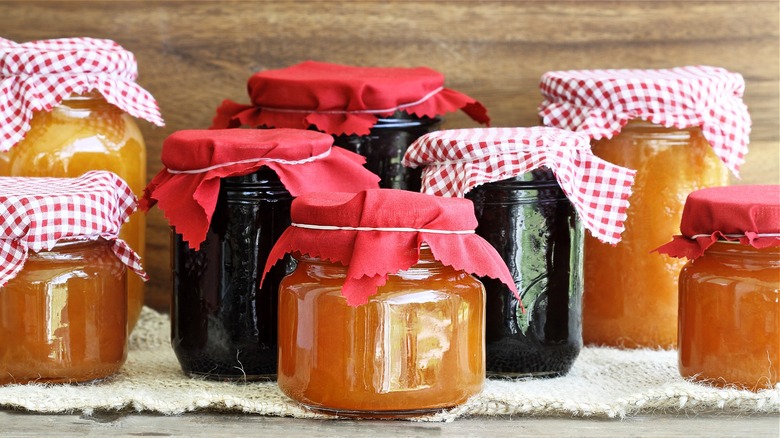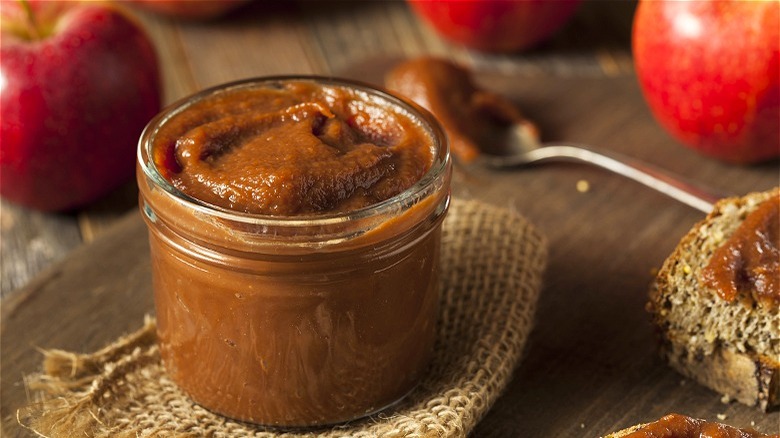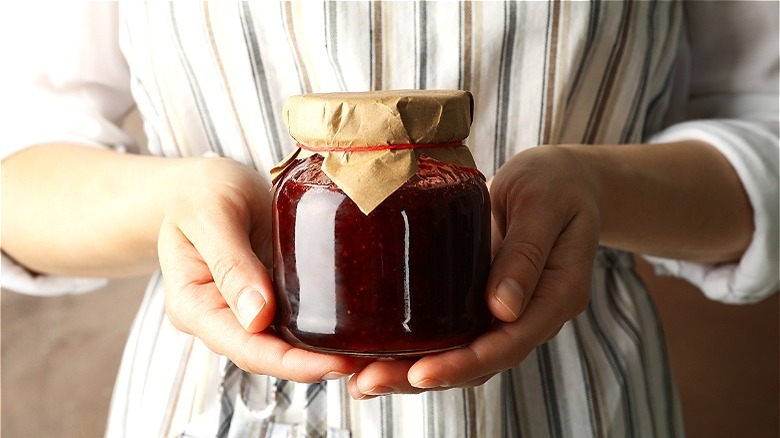Is Fruit Butter Actually Made From Butter?
When it comes to the wide range of spreadable delights to add to your morning toast, jam ranks pretty high on the list next to butter. In truth, however, there's no denying America's steadfast love for the creamy golden condiment. According to Statista, in 2021 alone, the average American consumed 6½ pounds of the stuff.
What about fruit butter? While most of us love fruit (not to mention the sweetness that comes with preserves, jellies, and jams), does fruit butter combine the best of both worlds, fusing together dairy solids and preserved fruit?
Unfortunately for those hoping to hear that it is chock full of milky goodness, there is no real butter in fruit butter. Truthfully though, there's no denying the deliciousness of fusing butter solids with other foods: While any number of savory homemade flavored butters may come to mind, Dairy Farmers of Canada also stress the tasty combination of butter and fruit to make apple jelly butter and strawberry jam butter.
Yet when talking specifically about real fruit butter, by definition these concentrated spreads don't actually contain any dairy products. This information may be confusing to those that take titles literally. If fruit butter doesn't actually contain butter, then why is butter used as a defining word for this luscious fruit spread?
Fruit butter explained
If you happen to have a jar or two of apple butter sitting in your pantry, then you're already privy to its thick, spreadable consistency. Even though fruit butter doesn't actually contain any dairy, the reason this spread is labeled as "butter" has to do with its texture. We all know the velvety suppleness a room-temperature slab of butter adds to a warm muffin, and the same goes for fruit butter. When you add a swipe of apple butter to a biscuit, the condiment provides a smooth, intense coat of pureed, cooked-down apples to your tender baked good, making your breakfast or snack even more indulgent.
Essentially, fruit butter is a concentrated fruit mixture made with varying sweeteners and an acidic agent like apple cider vinegar or lemon juice. This one-of-a-kind mixture is cooked on the stove for an extended period of time and then usually blended to create a more uniform final product. Unlike jam, fruit butter is slightly thinner and smoother, giving it that refined characteristic of silky room-temperature butter. Additionally, fruit butter is often made even more distinct through the use of warming spices such as cinnamon, ginger, and allspice. These smooth spreads also typically contain less sugar than traditional jams or jellies. Now that you know why fruit butter denotes the term "butter" in its descriptive title, you should try to make some right in your own kitchen.
Making fruit butter couldn't be easier
Even though you can make store-bought jam taste homemade with just two simple ingredients, why go through the trouble of upgrading a purchased product instead of spending a few short hours crafting a real homemade spread from a small handful of ingredients? Fruit butter is most commonly made with apples, peaches, pears, plums, and apricots. During harvest season if you can score a good deal on a box or two of in-season fruits at your nearest farm stand, try making some fruit butter and experience its rich concentrated flavor.
To make your own fruit butter without common canning equipment like a sieve or proper strainer, first peel and remove the seeds of your intended fruit then slice fruits into large chunks and place them in a pot over medium heat on the stove. You'll want to cook the fruit until it becomes soft, then puree the contents with either a stick or high-powered blender. Then you'll cook the blended mix with any added sweeteners and spices of your choosing for one hour or until the mixture has thickened significantly. Lastly, you'll add any acidic ingredients such as lemon juice to even out the complexity of your fruit butter. Even though fruit butter doesn't exactly contain any real butter, its silky smooth texture makes it irresistible on baked goods and ice cream. It can also serve as a delicious accompaniment to cheese and crackers.


